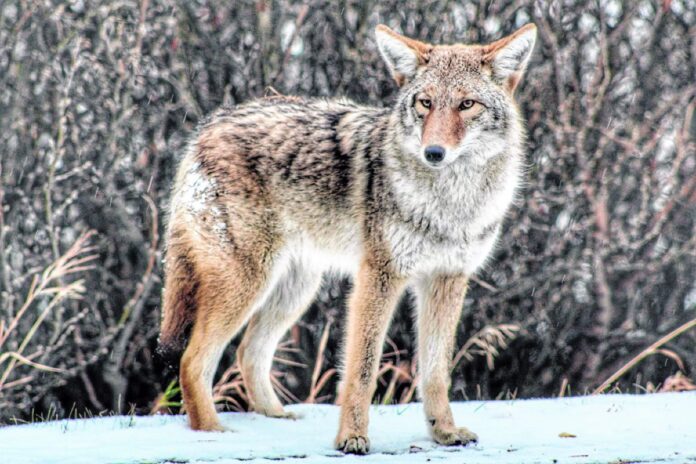HANCOCK COUNTY — Tonya Walls can hear the coyotes howling from her home on the east side of Greenfield, sandwiched between U.S. 40 and the Pennsy Trail.
She even saw a coyote make its way up to her second story deck one night after she left a bag of trash outside.
While their howls can sound ominous, state and local experts say coyote sightings are no reason to panic.
The Indiana Department of Natural Resources recently issued a statement stating that seeing coyotes, especially during winter, is normal and no cause for alarm.
Coyotes become more active during winter, according to the release. “Young coyotes are leaving their parents to find a new home, making them more visible. In January, coyotes will also be looking to breed, making them even more active. Bare vegetation also increases people’s chances of catching a glimpse,” it said.
Lais McCartney, agriculture and natural resources educator for the Purdue Extension Hancock County, said coyotes actually benefit humans and the environment in a number of ways.
They like to eat animals and plants that thrive around yards and homes, like rabbits, squirrels and fruit, as well as rodents.
“They do a lot of amazing things," McCartney said. “They eat a lot of moles and voles and chipmunks, which I know annoy a lot of people, and they keep the number of Canada goose eggs down."
McCartney often hears the coyotes’ familiar howls on her 17-acre wooded property in Knightstown, but she’s learned to peacefully coexist with them.
She makes sure to keep her chickens secured behind a fence, and locks them in their hen house at night to keep them safe. She’s lost a few chickens to foxes over the years, but none to coyotes, she said. Since coyotes can jump and climb over fences, she recommends adding an extra barrier like electric netting to protect chickens or other livestock during the day.
McCartney said coyotes can look especially intimidating in winter, when their thick winter coats make them look bigger than usual, but they can easily live in harmony with people.
“If they’re walking away from you, they’re just going from point A to point B,” she said. “But if you see an aggressive one that’s growling with its hackles up, that’s not a normal way to be acting, and should be reported to the DNR”s licensed wildlife control operators.”
While a coyote’s howl can sound ominous, McCartney said it’s simply the way coyotes communicate with one another. “When you hear them howling, they’re not hunting, they’re communicating with their families and trying to find a mate. Their peak breeding season is February, which is when you hear them the most,” she said.
Amanda DeHoney, director of Greenfield-Hancock Animal Management, encourages people to give coyotes space.
“The best piece of advice I can give is give them their space and monitor your animals outside,” she said.
Coyotes, which are classified as canines, are sometimes mistaken for dogs or wolves.
“If you think you found a dog but aren’t sure if it’s a coyote, don’t approach it,” DeHoney said.
While coyote sightings are more common in rural areas, they’re often spotted in urban areas, too.
They’re common throughout the state, even in metropolitan areas like downtown Indianapolis, according to DNR.
According to the Urban Wildlife Information Network, an estimated 4,000 coyotes live in urban Chicago.
As for Walls, she now makes sure to keep her trash safely secured in a trash bin — and to keep a close eye on her chihuahua when it’s outside.
[sc:pullout-title pullout-title=”At a glance” ][sc:pullout-text-begin]
Wintertime is a prime time to spot coyotes in both rural and urban areas. According to the Indiana Department of Natural Resources, problems between coyotes and people are uncommon.
To prevent them, be proactive by removing food and water sources, keeping pets leashed or contained, and trying to scare a coyote when you see it. The IDNR suggests the following tips for making your yard less attractive to coyotes:
–Clean up fallen fruit from trees or gardens.
–Keep garbage secure.
–Make sure pet food and treats are not left outside.
–Take down bird feeders if you see a coyote around your yard; they could be attracted to the rodents eating the seeds.
–Never intentionally feed a coyote; it could lose its fear of people.
If you spot a coyote, the INDR suggests scaring the coyote away by doing the following:
–Yell.
–Wave your arms.
–Spray it with a hose.
–Throw tennis balls or small stones, but don’t throw anything that could be food, like apples.
–Carry a jar of coins or a small air horn to make noise.
Making a coyote feel unwelcome around people can help it maintain its natural fear of humans. Never corner or chase a coyote, according to the IDNR. They should always have a clear escape path to get away.
Find more information about coyotes, including fact sheets and a webinar, at wildlife.IN.gov/5688.htm. Other webinar resources, including tips for maintaining positive interactions with wildlife in general, can be found at on.IN.gov/fishwilded.
[sc:pullout-text-end]





